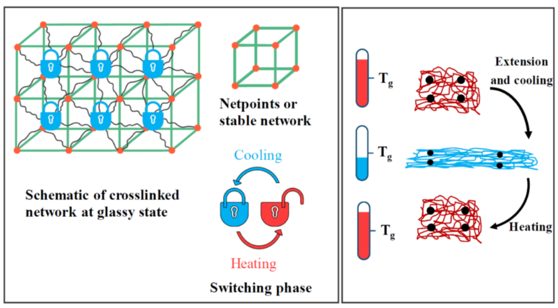LAMDA’s shape memory polymer research was featured in the latest Louisiana EPSCoR newsletter (View the newsletter as a PDF):
Machine learning boosts shape memory polymer materials research
by Amber King, Louisiana EPSCoR
Imagine you are packing for a long trip overseas, and you find your suitcase is entirely too small, your items are too heavy for the weight restriction, and you still have very expensive and fragile mechanical items yet to pack. Expand this problem to the size of a rocket, and you have the biggest engineering conundrum for space travel.
Scientists have developed an ingenious solution: Shape memory polymers. Let’s say a solar array for a satellite is being packed into a rocket. Shape memory polymers can replace the delicate hinges and mechanical gears required to open the panels. This allows the system to be packed highly compressed, weigh significantly less, and with no fragile metal parts. After the rocket reaches orbit, the compacted array can be launched, and when it is warmed by sunlight, voilà!, the shape memory polymers are activated and gently open it without a single gear. This technology was successfully employed with the SJ20 Geostationary Satellite launch in 2019.
Shape memory polymers (SMPs) are special synthesized materials that change shape when “activated” by a trigger such as heat, light, electricity, enzymes, magnetism, or pH solution. This material can be used in self-healing materials, parts of a soft robot, as an artificial muscle, geothermal drilling proppant, etc.
Dr. Cheng Yan has been applying his expertise in establishing SMP physical models by solid mechanics and leveraging machine learning to discover new SMP materials at Louisiana State University (LSU). He is a postdoctoral researcher as part of a collaborative research team with LSU and Louisiana Tech University researchers for the Louisiana Materials Design Alliance (LAMDA).
Photo: LAMDA postdoctoral researcher Dr. Cheng Yan works on a paper on one computer and runs machine learning codes on the laptop at Louisiana State University.
The LAMDA research alliance is funded by a $20 million cooperative agreement with the National Science Foundation and support from the Louisiana Board of Regents.
Machine learning is a sub-field of artificial intelligence, which is a powerful tool to endow the computer to learn and make decisions with less human involvement. Machine learning is able to overcome the brute force approach in traditional material discovery, thus saves a lot of time and money by allowing researchers to experiment virtually first, and then physically synthesize desired new materials in the lab.
But first, the appropriate machine learning algorithm has to be chosen, which requires the deep understanding and expertise for both material science and computer science. This being a relatively new field, there are not readily available databases for TSMPs yet, and manually collecting datapoints is quite time-consuming.
To solve this problem, a variational autoencoder model was trained to borrow knowledge from already-researched drug molecules from a big drug database and a small TSMP monomer/crosslinker database to find the desired new UV-curable TSMPs.
“Dr. Cheng Yan was the first to use the concept of transfer learning in solving the challenge of small training dataset in TSMPs. He successfully predicted five new types of TSMPs, and one of them has been validated through synthesizing and testing,” said Dr. Guoqiang Li.
“His machine learning framework not only works for discovering new TSMPs, but also works for guiding the design of other new polymers. These polymers have a great potential to be used in various engineering structures and devices,” added Li.
Illustration: (Left) A polymer must have a stable network and a switching phase to possess shape memory effect. (Right) A schematic showing the thermomechanical cycle. Source: H. Meng and G. Li. Polymer 2013, 54, 2199.
Yan’s research has contributed to 11 published papers in leading scientific journals in five years, and as a lead author or corresponding author for 10 of the papers, which is quite an accomplishment. He also was awarded “Best Paper” at the 16th International Conference on Computer Science and Education.
The LSU Mechanical & Industrial Engineering Department recently recognized Dr. Yan for these achievements with the 2021-2022 “Outstanding Research Assistant” award.
Math has been at the core of Yan’s interests since he was a child in Xinjiang, China. “I have always been interested in math. Math is the foundation of engineering, and we use math to translate physical problems in engineering. Just like Galileo Galilei said, ‘Mathematics is the alphabet with which God has written the universe,’ ” explained Yan.
Dr. Yan credits his mentor and advisor, Dr. Guoqiang Li, LSU’s Major Morris S. & DeEtte A. Anderson Memorial LSU Alumni Professor and John W. Rhea, Jr. Professor of Mechanical Engineering, for his motivation to research SMPs in Louisiana. “I read two papers about SMPs by Dr. Li in the Journal of the Mechanics and Physics of Solids, which I consider the best journal in solid mechanics, and decided right then that I wanted to be part of this research effort,” said Yan. “Dr. Li has been a good example for me and has given me a lot of motivation to go forward. We can learn a lot from him,” he added.
The next phase of Dr. Yan’s career in Louisiana continues, as he is preparing to start a new position as an Assistant Professor at Southern University and A&M College’s Mechanical Engineering Department.


